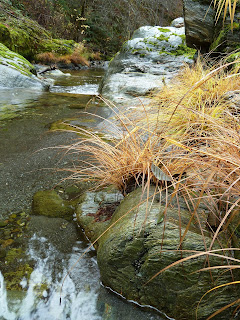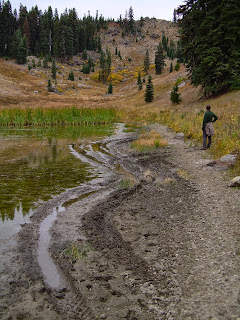 |
| The Salmon River at the mouth of Wooley Creek, a cold water tributary flowing from the Marble Mountains Wilderness. |
The Salmon River is one of the most remote and magical portions of the Klamath-Siskiyou bioregion. The region's wild beauty is unparalleled. Located between the Marble Mountains, Trinity Alps, and Russian Wilderness Areas, the watershed is the axis of connectivity and diversity in the central Klamath Mountains. The region's wild watersheds, spectacular high country and intact forests create one of the most important wilderness habitats in the west, including over 1 million acres of wilderness and roadless terrain spilling into the Salmon River from all sides.
The Salmon River has been designated a "key" watershed for the endangered salmon in the Klamath River. The Salmon River, a major tributary of the Klamath River, provides a number of intact cold water tributaries that are very important to the region's salmon and steelhead runs. It is also one of California's premier Wild and Scenic rivers, cherished for its water quality, wild beauty, recreational qualities, fisheries, roadless and wilderness habitats, and fire adapted forests.
The Salmon River Complex burned this past summer on both the main stem of the river and on the North Fork of the Salmon River near Sawyers Bar. The fires affected 37,246 acres of fire adapted mixed conifer
forest and montane chaparral. The complex actually consisted of two
separate fires, both of human ignition along Salmon River Road. The
Butler Fire, to the west, burned 22,467 acres while the Salmon River Fire
burned 14,779 acres.
Over the course of the last 36 years the Salmon
River Fire Area, located above Sawyers Bar, has been affected by three fires: the Hog Fire of 1977,
the Yellow Fire of 1987, and this season's Salmon River Complex. Combined, these fires have created a natural fire mosaic of mixed severity fire effects.
For instance, the Salmon River Fire burned a total of
14,779 acres, 10,658 acres (or 72%) burned at low severity, 22% at
moderate severity, and 5% at high severity. The impact of this fire,
although not a natural ignition, was well within the "range of natural
variability," not only in regards to fire severity and mosaic, but also
fire return interval, which is currently about 12 years. Tree ring
research in the Salmon River watershed has estimated an 11-17 year fire
return interval in the historic environment.
 |
| The Salmon River Fire above Sawyers Bar, CA (Photo Courtesy of Klamath Forest Alliance) | |
The Salmon River Fire is currently being targeted by the Klamath National Forest (KNF) for salvage
logging and extensive "hazard tree removal" within roadless areas, Late Sucessional Reserve (LSR) forest, critical habitat for the Northern spotted owl, and adjacent to both the
Marble Mountain Wilderness and the Wild and Scenic Salmon River. The proposal calls for salvage logging 334 acres in forests effected by both moderate and high severity fire.
These 16 units, spread out across the fire area, include stands that consist of 50% tree mortality. The project also calls for the removal of living trees that the agency has deemed as having a "70% probability of mortality." This will provide agency timber managers large levels of leeway in identifying both stands that were impacted by "uncharactertistic fire effects" as well as identifying individual trees for removal that survived the 2013 fires. The problem with these timber sale marking guidelines and stand identification techniques is that according to the fire severity mapping on this fire, only 8% of the fire area was affected by high severity fire; such impacts are well within the natural range of variability for this forest type and thus no areas can be described as sustaining "uncharacteristic fire effects." The burn mosaic was natural and productive, creating diversity, complexity and fire adapted forest patterns; small areas of high severity fire are not "uncharacteristic." Salvage logging the fire's few high severity patches will only limit the forest's ability to regenerate naturally and impact biodiversity. Likewise, the logging of live trees that survived the Salmon River Fire will only skew the fire mosaic towards higher levels of mortality than would otherwise be evident. The fire was, in effect, a large landscape-scale restoration treatment that encouraged healthy fuel conditions and is in no need of restoration through silivicultural means.
 |
| A view of salvage logging units near Kelly Gulch. The agency has identified stands affected by moderate severity fire and suffering only 50% mortality as timber sale units. (Photo Courtesy of Klamath Forest Alliance) |
The agency is also proposing extensive "hazard tree removal" along 33 miles of roads in the Salmon River watershed, including currently low standard roads that receive very little use. Commercially viable trees felled in hazard tree treatments will be yarded and logged for timber. Hazard Tree logging will effect 1,538 acres of habitat, 978 acres of which is critical habitat for the Northern spotted owl.
The proposal also includes the reopening of two currently overgrown and impassable road segments, one of which appears to include "new" road construction. The agency will also create five new landings, scraped into the steep, unstable hillside throughout the project area.
 |
| Salmon Salvage Project unit and road "reconstruction" site. (Photo Courtesy of Klamath Forest Alliance) |
Rehabilitation work could occur within the firelines created during the Salmon River Fire, including 8 miles of handline and 5 miles of dozerline. These areas could be water-barred, the slash burned, and access by OHVs adequately blocked. Likewise, the agency should consider a strategy of prescribed fire, prescribed natural fire, and appropriate fire suppression techniques that will encourage fire adapted landscapes, natural fuel conditions, and fire safety for the residents of the Salmon River. The agency could work with local residents and non-profits such as the Orleans Fire Safe Council, the Northern California Prescribed Fire Council, the Salmon River Restoration Council, and the Klamath Forest Alliance to conduct prescribed fires to reduce fuels on both federal lands directly adjacent to rural residences and communities, as well as on private lands where human values and homes are likely to be threatened in future wildfires. Back country salvage logging (the plan currently does not require slash clean up or removal) and plantation-like tree planting will not address community protection concerns, fuel risks, or facilitate a natural recovery within the fire area. In fact, the units proposed are not strategically located to provide community protection, but identified based on economic feasibility.
Please contact the Klamath National Forest and ask them to:
1) Cancel the Salmon Salvage Project and start a new planning process that focuses on prescribed fire, prescribed natural fire, and community protection concerns.
2) Cancel all proposed salvage logging units in riparian reserves, LSR forest, sensitive soil types such as decomposed granite, and within critical habitat for the Northern spotted owl.
3) Cancel "hazard tree removal" on secondary roads.
4) Cancel the proposed "temporary road" reconstruction and any new road construction needed.
5) Eliminate the need for the creation of 5 new landing pads on steep, sensitive soil types throughout the project area.
6) Address and mitigate the impacts of fireline construction and fire suppression activities within the fire area utilizing both active and passive forms of restoration.
7) Create a fire management plan for the Salmon River Watershed that will outline and define acceptable fire suppression activities throughout the Salmon River area. The agency could identify community protection concerns, ingress and egress for fire evacuation, minimal impact suppression tactics and options, appropriate fire suppression techniques for LSR forests, inventoried roadless areas, wilderness areas, wild and scenic rivers, botanical areas, etc. The agency could also analyze past suppression activities, back burning, and fireline locations to identify concerns, successful actions, inappropriate actions, and ways of improving firefighting effectiveness and community safety while minimizing fire suppression impacts to sensitive areas and resources.
Written comments are due by December 26, 2013 and can be submitted through the following avenues:
Fax:
(530) 468-1290
Mail:
District Ranger Dave Hays
ATTN: Travis Coughlin
Salmon/Scott River Ranger District Office
11263 N. Hwy 3
Fort Jones, CA
96032
Email:
comments-pacificsouthwest-klamath-salmon-river@fs.fed.us
For more project information contact interdisciplinary team leader Travis Coughlin at (530) 468-1261 or TCoughlin02@fs.fed.us




















































